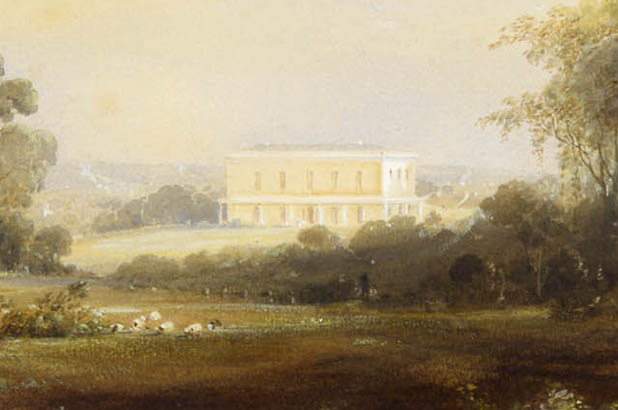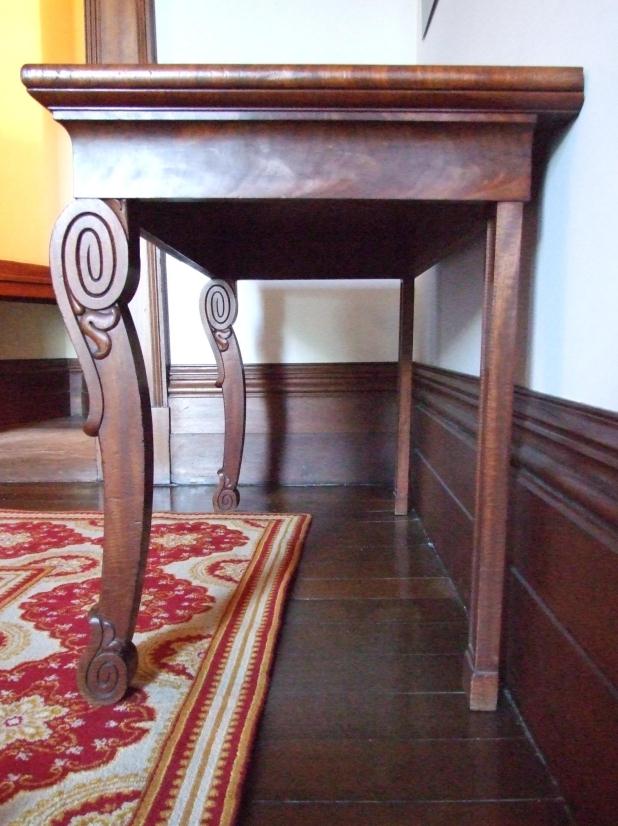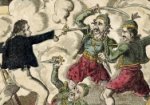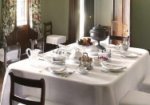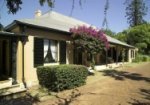This week in 1836 Maria and Hannibal Macarthur entertained a notable guest at their home, Vineyard – Charles Darwin!
Are you sitting comfortably? Because this luncheon tale is a ‘who’s who’ that’s going to take a little while to unravel…
Darwin in Sydney
Darwin arrived in Sydney on 12 January 1836 on board the Beagle, returning to Britain from South America. The captain, Robert Fitzroy, made this observation of a colony in the midst of the booming 1830s:
[Sydney] may be faithfully compared to the large suburbs which stretch out from London & a few other great towns:— but not even near London or Birmingham is there an aspect of such rapid growth; the number of large houses just finished & others building is truly surprising; nevertheless every one complains of the high rents & difficulty in procuring a house.
So not much has changed. In Darwin’s own diary the entry for 27 January reads:
Accompanied by Capt. King rode to Paramatta [sic]. Close to the town, his brother in law Mr [Hannibal Hawkins] MacArthur lives & we went there to lunch. The house would be considered a very superior one, even in England. — There was a large party, I think about 18 in the Dining room. — It sounded strange in my ears to hear very nice looking young ladies exclaim, “Oh we are Australian, & know nothing about England”. — In the afternoon I left this most English-like house & rode by myself into Sydney.
While it seems extraordinary that Darwin would not also have visited the garden of Alexander Macleay at Elizabeth Bay House, with its botanical treasures, his journal make no mention of the colonial secretary nor his vast natural history collection. The Sydney Monitor, 27 January 1836, does however record that Macleay “gave a splendid fete at his villa at Elizabeth Bay on Saturday [23rd January] last. It was attended by the officers of HMS Beagle and Zebra, many of the military and civil officers and a number of inhabitants”. While the house itself was still under construction, the gardens were already established. Darwin meanwhile was still returning from a tour inland over the Blue Mountains to Bathurst.
Alexander’s son, William Sharp Macleay who was then resident in London, was to play perhaps a decisive role in Darwin’s later career – and in the course of science itself:
During the last week several of the zoologists of this place [London] have been urging me to consider the possibility of publishing the ‘Zoology of the Beagle’s Voyage’ on some uniform plan. Mr. [W. S.] Maclay [sic] has taken a great deal of interest in the subject, and maintains that such a publication is very desirable because it keeps together a series of obsevations [sic] made respecting animals inhabiting the same part of the world, and allows any future traveller taking them with him … I never should have thought of this plan, if M’Clay [sic] had not been so kindly urgent on my taking it into consideration, and now I daresay the egg from the want of a little government hatching will be addled.Darwin to the Reverend Leonard Jenyns, 10 April, 1837
A colonial who’s who
The crew manifest on the Beagle is a bit of a colonial ‘who’s who’, as many stayed in, or returned to Australia to live. Several even married into the Macarthur clan.
Philip Parker King, Maria Macarthur’s brother, had been commander of HMS Adventure, which accompanied the Beagle on its famous voyage. His own son, Philip Gidley King the younger (named for his grandfather), sailed on the Adventure then transferred to the Beagle as midshipman. In this 1799 portrait (below) of the King family, young Philip Parker is shown sitting next to his father, (Governor) Philip Gidley King Snr., and his sister (Anna) Maria:
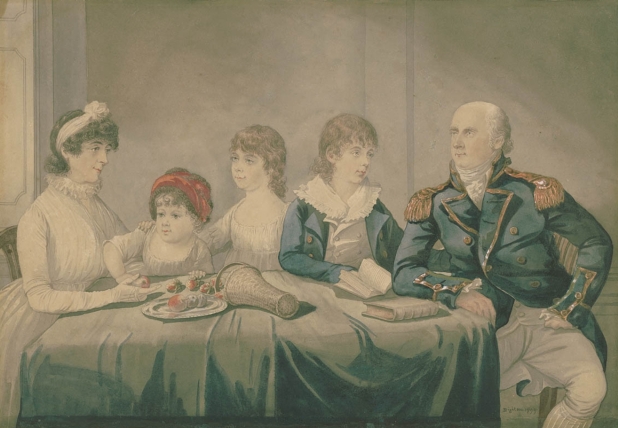
[Philip Gidley and Anna Josepha King, and their children Elizabeth, Anna Maria and Phillip Parker], Robert Dighton, 1799. State Library of New South Wales: ML 1244
I sometimes hear news of Australia from Syms Covington (my old servant in the Beagle) who is settled at Twofold Bay, & writes to me every year. He has had an attempt at the diggings [the goldfields], but ended by selling at a large profit a 6-month stock of provisions. I also hear news from our neigbours the Normans; for Mrs. Norman’s sister is Mrs. Macarthur, (Mrs. King’s cousin I fancy). I was dining there two or three days ago, & I heard that the Macarthurs complain of the Colony much as your Father does.
The ‘Emily’ that he mentions is Emily Stone, who had married James Macarthur, second son of John and Elizabeth! The 19th century was a very small world it seems.
Robert Fitzroy, Captain of the Beagle, was the half brother of Sir Charles Fitzroy, Governor of New South Wales from 1846 to 1855, and was himself Governor of New Zealand from 1843 to 1845. We’ll get back to him shortly.
Lt. John Clements Wickham was second in command of the Beagle. Wickham, a leading hydrographer, would himself command the Beagle from 1837 till his retirement in 1841 on the ship’s third voyage. The purpose of that voyage was to chart the coastline of Australia, including Bass Strait, Western Australia, the Gulf of Carpentaria and north-western waters, before mapping areas of New South Wales and what would become the new colony of Queensland.
John Lort Stokes, who served over 18 years on the Beagle, also accompanied Wickham on his Australian survey expeditions. Stokes charted the site of the town that they named Port Darwin in honour of their previous shipmate. It is now known simply as ‘Darwin’. On Wickham’s retirement, Stokes assumed command of the ship, returning to London in 1843.
Syms Covington, Darwin’s assistant and ‘shooter’, also emigrated to Australia and maintained a correspondence with the famous naturalist. Originally a crewman on the Beagle, he had proved so valuable an assistant and taxidermist that he was transferred formally to Darwin’s employment. Several years later, Covington, a religious man dismayed by the implications of Darwin’s research to which he had, ironically, been integral, emigrated to Australia. Darwin wrote to William Sharp Macleay to see if the fellow naturalist could find employment for his Beagle assistant. Covington actually found work with the Australian Agricultural Company, quite possibly through a member of its board – Philip Parker King, his old shipmate’s father.
Years later Darwin was delighted to read of his old Beagle shipmates from the pages of colonial newspapers used by Covington to wrap specimens he sent back to Darwin. A letter from Darwin dated 22 Feb., 1857 ends:
I lately dined with one of your great Australian potentates, Sir W[illiam]. Macarthur [younger brother of James], and heard a good deal of news of Australia, and drank some admirable Australian wine. Yours is a fine country, and your children will see it a very great one. With every good wish for your health and prosperity, I am, dear Covington, yours sincerely, CH. DARWIN.
And the rest?
But back to Maria and Hannibal Macarthur.
Their daughter Anna would in turn marry King’s fellow officer from the Beagle, John Clements Wickham, in 1842. Until her early death, the two turned their own home ‘Newstead’ into the social centre of the infant town of Brisbane, the Northern equivalent of her father’s ‘Vineyard’.
In a typical example of the tightly connected world of colonial society – and particularly that centred on the Macarthur clan’s estates at Vineyard and Camden – Wickham had bought Newstead from Patrick Leslie, the nephew of Walter Davidson, who was in turn the nephew of John Macarthur’s patron Sir Walter Farquhar, and who in 1840 married Catherine, another of Hannibal Macarthur’s daughters.
In 1856 Leslie purchased the view of Vineyard [above] from Conrad Martens, apparently giving it to his brother George Farquhar Leslie, who had himself married Emmeline Maria Macarthur. To neatly complete this matrimonial tangle, in 1843 Anna, Catherine and Emmeline’s sister Elizabeth married – can you guess who’s left? – her cousin Philip Gidley King.
Got all that? There’ll be a quiz at the end.
Vineyard, and Conrad Martens’ view
Conrad Martens settled in Sydney and became a society painter to the colonial gentry. He had been expedition artist on the Beagle for a time, replacing the ill Augustus Earle who would also work in Sydney. In his view of Vineyard [detail, above] the dining room where Darwin was entertained is behind the windows on the right corner. Sadly, Vineyard – sold by a bankrupt Macarthur in 1848, converted to a convent and renamed Subiaco – was demolished in 1961 to make way for a car park. Some fragments survive: a column capital (below) is in the collection at the Caroline Simpson Library & Research Collection. The stone colonnade columns are now a fine pergola at the University of NSW. On display in the library at Elizabeth Bay House a wooden plinth, holding a bust of William Sharp Macleay, is a section of a cedar column from the house’s interior, and in the dining room are two cedar serving tables, designed in the office of John Verge, and from which Darwin’s lunch was served 183 years ago this monday!
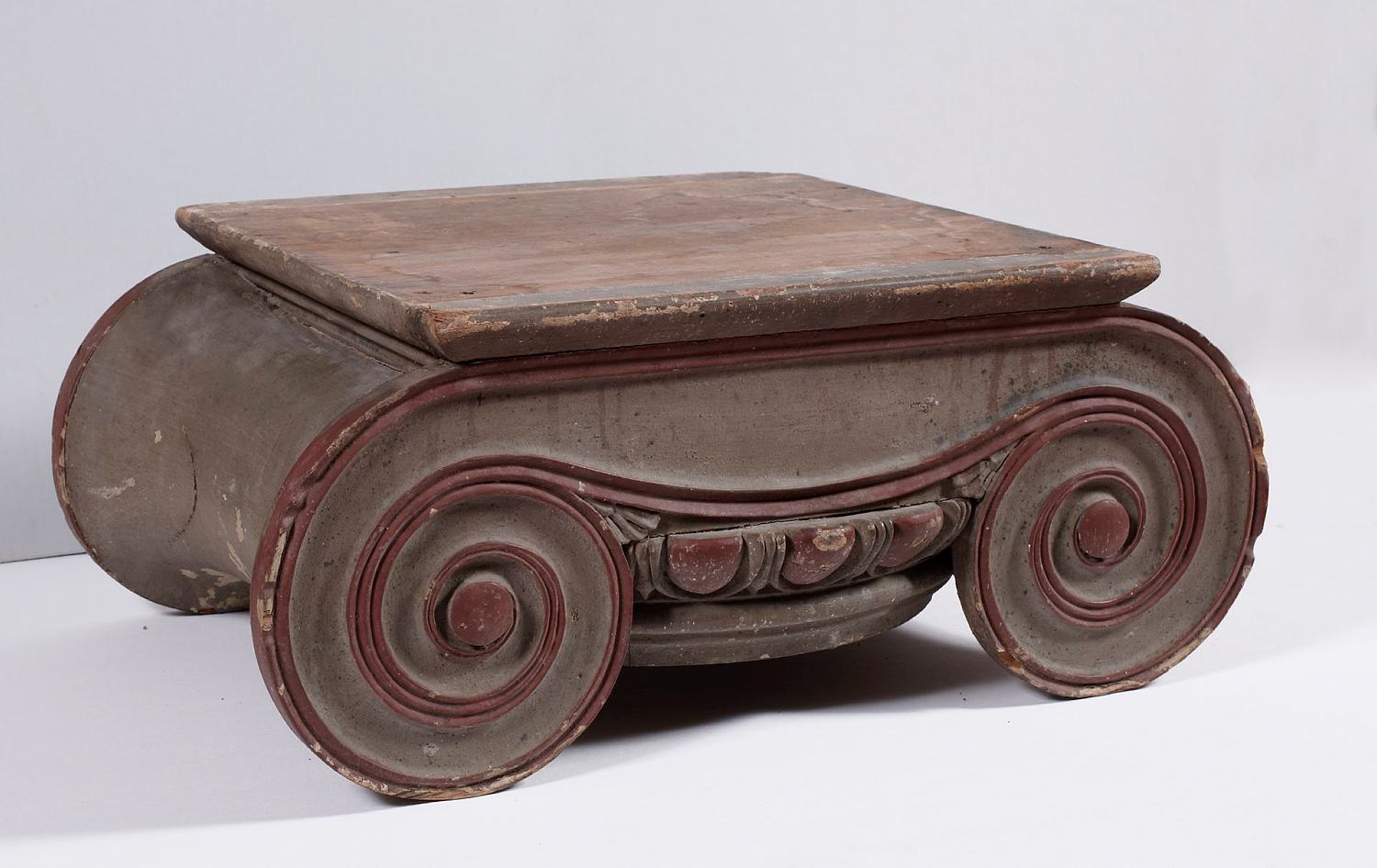
A painted wooden Ionic capital, an architectural fragment from Subiaco. Caroline Simpson Library & Research Collection, Sydney Living Museums. Photo © Jenni Carter for Sydney Living Museums L93/20-4
You can dive into Darwin’s correspondence in the Darwin Project at http://darwinproject.ac.uk
Another view of Vineyard, in the collection of the Mitchell Library, can be seen here.
The sideboard designed in Verge’s office for Vineyard, and from which the wines were served at the lunch Darwin attended, also survives, and is also in the Elizabeth Bay House collection. Later modified to serve as a font when Vineyard became a convent, and with a sizeable hole in its top as a result, it is not on display.
